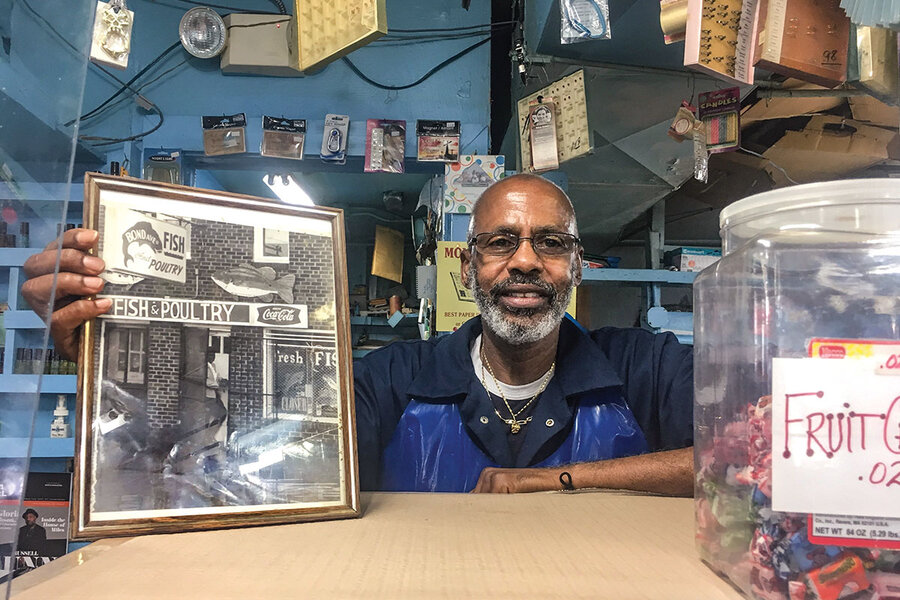This East St. Louis grocer tends an oasis of uplift in a food desert
Loading...
| East St. Louis, Ill.
Terrence Conrad is the son and grandson of grocers who ran the Bond Avenue Fish and Poultry corner store in East St. Louis. He grew up in this industrial city across the Mississippi River from St. Louis when it was bustling and every lot was built out. But, in the past half century of Rust Belt decline, this town’s population dropped from nearly 80,000 to close to 20,000.
Mr. Conrad, however, after college and starting a career in regional planning in Pittsburgh, came back. He carries on the family’s eclectic emporium of fish, household hardware, and fresh produce – a busy, bright blue hub of activity that stands out from surrounding vacant lots. It’s full of life – yelled greetings, laughter, conversation – and food that residents would have to drive miles to find elsewhere. It’s an oasis in a food desert where the average distance to a supermarket is almost 3 miles.
“We’re needed here,” says Mr. Conrad, who runs the store with his wife, Robin. “[Around here] you won’t find any fresh food. You won’t find any fresh seafood. We try to stay in this area to meet the needs of the people that are here.”
Why We Wrote This
While thousands of residents in the last half of the 20th century fled the urban troubles of East St. Louis – a once dynamic hub of industry and rail across the Mississippi from St. Louis – Terrence Conrad came home.
“All right Mrs. Conrad, it’s 9 o’clock,” yells Terrence Conrad to his wife as he closes the display cooler, stocked full of fish for the day. He walks to the front door, turns the key in the lock, and the bustle begins.
The phone rings. The door buzzes again and again as customers wander into the packed emporium, where produce and old-fashioned candy line the shelves, and oil funnels, paintbrushes, and children’s toys hang from ceiling hooks.
One young woman walks through the maze of merchandise to the counter and introduces herself: “I’m the Humphreys’ granddaughter,” she says.
Why We Wrote This
While thousands of residents in the last half of the 20th century fled the urban troubles of East St. Louis – a once dynamic hub of industry and rail across the Mississippi from St. Louis – Terrence Conrad came home.
At another store, introducing yourself to the cashier is likely to generate a blank and confused stare, but the Conrads react like they’ve run into an old friend. “Oh, the firefighter!” Mrs. Conrad exclaims. “You look just like your grandfather,” adds Mr. Conrad.
They wrap up her fish, and slipping a note with it over the counter, Mrs. Conrad says: “To give to Grandma. Tell her we miss her.”
Bond Avenue Fish and Poultry is a powerful magnet of commerce and community. The store evokes memories of the mid-20th-century golden years when East St. Louis was a thriving transportation and industrial hub. Now gutted by deindustrialization and white and Black flight, the city is a largely empty, boarded-up landscape.
The Conrads’ busy, bright-blue corner store stands out from surrounding vacant lots. It is full of life – yelled greetings, laughter, conversation – and food that residents would have to drive miles to find elsewhere.
The couple have held to their deep roots here, staying for the very reasons others left. They see great need and provide not just essential food and household items, but a place to connect, build trust, and see good.
“We’re needed here,” says Mr. Conrad, who gave up his full-time job as a regional planner in Pittsburgh in 1977 to help his father run the store his grandfather started. “[Around here] you won’t find any fresh food. You won’t find any fresh seafood. We try to stay in this area to meet the needs of the people that are here.”
An oasis in a food desert
Mr. Conrad’s grandfather, Rollie Conrad, left his work in the fields of rural Mississippi in the early 20th-century Great Migration of Black Americans escaping the racial oppression of the South for economic opportunity in the North. Working for an East St. Louis German Jewish grocer, the elder Conrad hatched the idea of going into business for himself and rented a Bond Avenue storefront in 1945. But white vendors wouldn’t sell goods to a Black businessperson, so his former employer suggested Rollie simply say he was still buying for the German man – a workaround he had to continue for several years. In 1954, at the population peak here of 82,000, Rollie built the store that still stands.
But factories closed in the 1960s, says Andrew Theising, a professor of political science at Southern Illinois University Edwardsville, and “by 1970, East St. Louis has skyrocketing unemployment, it has poverty, and there are even stories of children suffering from starvation.”
Today, East St. Louis has a population of less than 27,000. In 2019, it had a violent crime rate three times the national average. A third of the population lives below the federal poverty line. And hunger persists. According to the USDA Food Access Research Atlas, East St. Louis is a food desert – a significant share of residents are low income and live more than a mile from a supermarket. A 2017 survey conducted by Make Health Happen and the University of Illinois Extension program found that the average distance to a liquor store from public housing in East St. Louis was less than half a mile; the average distance to a grocery store was 2.96 miles.
The Conrads are working to change those numbers. In 2015, they expanded their staple offerings beyond fish and deli meat to produce – apples, oranges, bananas, cucumbers, lettuce – sourced from local farmers.
Most of those who buy produce from the Conrads walk from nearby public housing projects and a senior center. While produce doesn’t always sell out – Mr. Conrad estimates that they only sell 60% to 70% – it’s an option those who rely on it wouldn’t have otherwise. To make up for the loss on produce that goes bad, the Conrads sell at a 15% markup, which allows them to break even. If they can give away the produce for free before it spoils, they do.
“They do what seems like small things, but they really are big things,” says Amy Funk, a University of Illinois Extension Supplemental Nutrition Assistance Program educator. “That little store symbolizes a solution that we want to see duplicated throughout East St. Louis and other communities that are experiencing similar issues.”
A different business model
Adding fresh produce to inventory was a natural evolution of the Conrads’ philosophy: See a need and meet it. For them, it’s not just about resolving issues of food access. It’s about a more holistic solution that addresses both material and spiritual needs.
“When our customers come, they come for natural food. [But] we feed them ...
spiritual food,” says Mr. Conrad. “You can just talk to someone. Give them some godly counsel. Anything that’s in the Bible you can say in your own words, but they’re still godly principles.”
And talk they do. Coming into Bond Avenue Fish and Poultry isn’t meant to be an expeditious experience. Even as customers line up, Mr. and Mrs. Conrad focus completely on the person in front of them. They ask about the mother in the hospital, the son who just left for college.
No one gets annoyed. No one gets impatient.
“Things are tough for people. They really are. And you never know who you’re entertaining; ... you don’t know what people are going through when they come through the door,” says Mrs. Conrad. “[A] kind word will always do good.”
It’s a different business model. Their son Jabari calls it Christian capitalism: “Even though you have to turn a profit ... there are still ways to contribute to the community.”
Staying rooted
For many East St. Louisans, the store symbolizes the larger good in the community not often highlighted.
“I’ve grown up in East St. Louis all my life. I’ve never been robbed. My house has never been broken into. Nothing has ever been taken from me on the street. I feel free to walk the streets anytime I want,” says Gary Gaston, the pastor of the church that sits just across the corner from Bond Avenue Fish and Poultry.
“We have a lot of good in our city,” he adds. This store “is proof of the type of community within a community that exists within the city of East St. Louis: individuals that are ... trying to ensure that the city maintains vital services.”
It also pulls people raised here back to their roots from surrounding suburbs.
“[The Conrads] are like family,” says local resident Sandy Johnson, adding to her order from a bank of jars of Big Bol Candy Bubble Gum and Mary Jane bars.
“It’s a neighborhood store that you can depend on. ... Rain, sleet, or snow, they’re going to be here and always with a smile,” says Douglas Borders, who grew up a quarter mile away.









